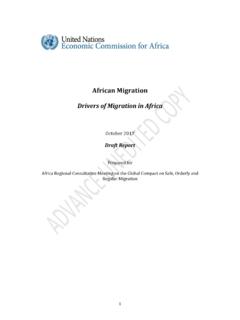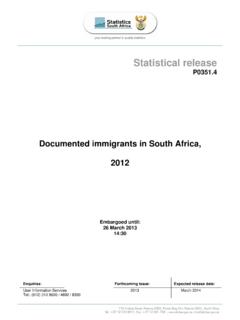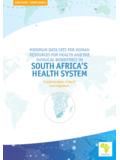Transcription of Gender Discrimination in India - IOSR Journals
1 IOSR Journal of Economics and Finance (IOSR-JEF) e-ISSN: 2321-5933, p-ISSN: 2, Issue 5 (Jan. 2014), PP 55-65 55 | Page Gender Discrimination in India , , , , Post Doctoral Fellow Dept of Economics Acharya Nagarjuna University Nagarjuna Nagar. I. Introduction: After independence in India one of the issues which has attractive the attention of the policy makers was Gender issues and concerns. Gender issues have become central policy arena. The issues of Gender equality and justice assumed added significance in the context of the interface between new economic policy perceptions and Gender relations. The Gender equity became part of country s strategy for eradicating poverty and human misery.
2 The policy makers are strongly believed that a positive commitment to Gender equality and equity will strengthen every area of action to reduce poverty because women can bring new energy and new insights. A lot of debate is going on women and development since last few decades. Several interventions had taken place both at national and international level leading to passing of several loss including loss against physical violence IPC Section 498 (a) and Section 125 for maintenance. The importance of feminism has been steadily growing and gaining intellectual legitimacy. II. Developments at Global Level: There has been global effort with a strong support from , since 1975 to understand the Discrimination and restore status of women through equality, development and peace.
3 The year 1975 was declared as the international year of the women by the United Nations. It organized 4 world conferences on at Mexico in 1975, one at Copan Hagen in 1980, one at Nairobi in 1985 and one at Beijing in 1995. The World Summit for Children 1990, set goals for health, education and nutrition for women and their children. The international conference on nutrition in 1992 held at Rome, emphasized the elimination of malnutrition among women and children. The international conference on population and development in 1994 brought out a link between demographic issues and advancement of women through education, health and nutrition. The 1994 international conference on population and development placed issues of Gender at the center of discussion.
4 Thus, several international organizations are trying to promote the advancement of women and their full participation in developmental process and trying to eliminate all forms of Discrimination against women. III. Developments in India : The most deep-rooted forms of Gender inequality had been built into the structure of traditional Indian society. Through Gender inequality exists a large measure in the society under different dimensions for long time, its importance has grown in the recent times only. In the traditional society the inequality between males and females existed to a large extent. Women were looked down socially, economically and politically.
5 Women became scape goats of many traditions and customs. She was brutally killed in the name of Sathi. The practice of child marriage, Kanyasulkam, Prostitution was taken it granted by society and women has no voice what so ever for centuries together. Women s role was restricted to domestic life especially kitchen work and bearing and rearing of children. She has no place in economic and political activities. Girl children were discriminated in terms of basic necessities of life such as food, clothing and shelter. Woman is the last person in the family to eat. She is the person who does all types of menial jobs. There is no respect for her work. Most of the women s work outside the domestic front is restricted to agricultural labour activity (in agriculture) and unorganized activities in urban sector.
6 The census of India did not consider their work while counting the number of economically active persons in the country for quite a long time. The Government of India has taken several measures and also making endeavourer to hoist the status of women in the society in order to promote equality of men and women. The different plans, programmes, and policies have laid emphasis on women empowerment and raising the economic, educational, health and political participation of women to match with that of men. The draft national policy on empowerment of women envisages 1) to setup councils at the national and State levels to review the implementation of the recommendations of the national and State Commissions for women.
7 2) The center and State to draw up time bound action plans to translate this policy into concrete action in consultation with the Central and State Commissions for women. (3) Every ministry at the Center and the State is obliged ensure equal flow of benefits in physical and financial terms to Article 15 of the constitution prohibits any Discrimination on grounds of sex. The directive principles of State policy also urges that the State shall direct this policy towards securing an adequate means of livelihood for women and ensuring equal pay for equal work for both men and women. Since seventy s the objectives of Gender Discrimination in India 56 | Page raising the status of women and also been included in different five years plans.
8 In the sixth five year plan emphasis was laid on raising the employment status of women. The seventh plan emphasized the need for human resource development in women. The eighth plan aims at enabling women to function as equal partners and implement social legislation for women effectively. The ninth plan has identified empowerment of women as an objective. The tenth plan also emphasis on women development. The formulation of the national commission for women ( ) and the idea of setting of a national council for empowerment of women are encouraging steps in this direction. Also different state governments are also implementing several development measures for women s health in general and re-productive health in particular.
9 The lack of sex education among adult girls and re-productive health education among the married women are also cause of many preventable diseases. Empowering women regarding the own re-productive health care and effecting accountability of men towards women s re-productive health are important for promoting women health status in the society. Now with the efforts of national and international organizations several laws were passed and some laws were changed. But still women continue to suffer from many social and economic and political disadvantages, since the attitudes did not change as fast as the change in laws. Gender issues are ideologically motivated and need a change in mindset in terms of attitudes and behavior of both men and women of all dimensions.
10 IV. Objective and Data Base: The main objective of the present paper is to examine the Gender Discrimination in India in demographic social, economic and political context. The data required for the present paper was collected from secondary sources. The women Discrimination can be visualized on various angles. In a male dominated society like ours one has to accept that women are at the receiving end. The sex ratio is unfavorable to women and it has declined overtime. The literacy rates are low among women. The expectation of life is low for women in India up to the recent times. The opportunities and access to decision-making institutions are not equal to both men and women.














